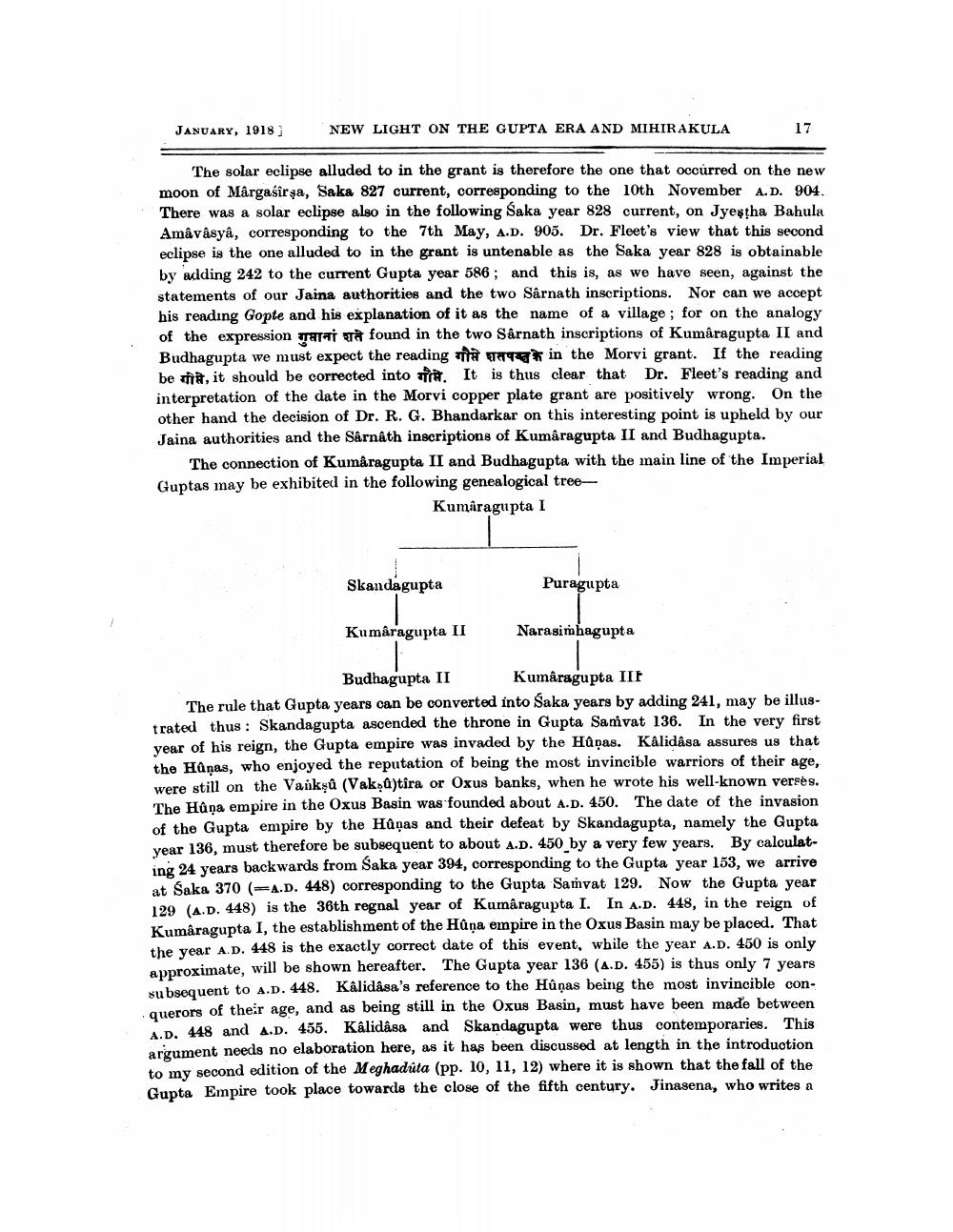________________
NEW LIGHT ON THE GUPTA ERA AND MIHIRAKULA
17
The solar eclipse alluded to in the grant is therefore the one that occurred on the new moon of Mârgasîrșa, Saka 827 current, corresponding to the 10th November A.D. 904. There was a solar eclipse also in the following Saka year 828 current, on Jyestha Bahula Amâvâsya, corresponding to the 7th May, A.D. 905. Dr. Fleet's view that this second eclipse is the one alluded to in the grant is untenable as the Saka year 828 is obtainable by adding 242 to the current Gupta year 586; and this is, as we have seen, against the statements of our Jaina authorities and the two Sârnath inscriptions. Nor can we accept his reading Gopte and his explanation of it as the name of a village ; for on the analogy of the expression Tata To found in the two Sarnath inscriptions of Kumâragupta II and Budhagupta we must expect the reading T y in the Morvi grant. If the reading be fa, it should be corrected into Tra. It is thus clear that Dr. Fleet's reading and interpretation of the date in the Morvi copper plate grant are positively wrong. On the other hand the decision of Dr. R. G. Bhandarkar on this interesting point is upheld by our Jaina authorities and the Sârnâth inscriptions of Kumâragupta II and Budhagupta.
The connection of Kumâragupta II and Budhagupta with the main line of the Imperial Guptas may be exhibited in the following genealogical tree
Kumaragupta I
Skandagupta
Puragupta
Kumâragupta II
Narasimhagupta
Budhagupta II Kumâragupta IIF The rule that Gupta years can be converted into Saka years by adding 241, may be illustrated thus: Skandagupta ascended the throne in Gupta Samvat 136. In the very first year of his reign, the Gupta empire was invaded by the Hûnas. Kalidasa assures us that the Hûņas, who enjoyed the reputation of being the most invincible warriors of their age, were still on the Vankşû (Vakşû)tira or Oxus banks, when he wrote his well-known versės. The Hûna empire in the Oxus Basin was founded about A.D. 450. The date of the invasion of the Gupta empire by the Hûņas and their defeat by Skandagupta, namely the Gupta vear 136. must therefore be subsequent to about A.D. 450_by a very few years. By calculating 24 years backwards from Saka year 394, corresponding to the Gupta year 153, we arrive at Saka 370 (A.D. 448) corresponding to the Gupta Samvat 129. Now the Gupta year 129 (A.D. 448) is the 36th regnal year of Kumâragupta I. In A.D. 448, in the reign of Kumâragupta I, the establishment of the Hûna empire in the Oxus Basin may be placed. That the year A.D. 448 is the exactly correct date of this event, while the year A.D. 450 is only approximate, will be shown hereafter. The Gupta year 136 (A.D. 455) is thus only 7 years subsequent to A.D. 448. Kalidasa's reference to the Hûņas being the most invincible conquerors of their age, and as being still in the Oxus Basin, must have been made between A.D. 448 and A.D. 455. Kalidasa and Skandagupta were thus contemporaries. This argument needs no elaboration here, as it has been discussed at length in the introduction to my second edition of the Meghadúta (pp. 10, 11, 12) where it is shown that the fall of the Gupta Empire took place towards the close of the fifth century. Jinasena, who writes a




